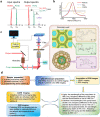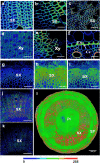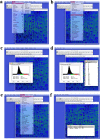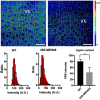A label-free, fast and high-specificity technique for plant cell wall imaging and composition analysis
- PMID: 33741013
- PMCID: PMC7980347
- DOI: 10.1186/s13007-021-00730-9
A label-free, fast and high-specificity technique for plant cell wall imaging and composition analysis
Abstract
Background: New cell wall imaging tools permit direct visualization of the molecular architecture of cell walls and provide detailed chemical information on wall polymers, which will aid efforts to use these polymers in multiple applications; however, detailed imaging and quantification of the native composition and architecture in the cell wall remains challenging.
Results: Here, we describe a label-free imaging technology, coherent Raman scattering (CRS) microscopy, including coherent anti-Stokes Raman scattering (CARS) microscopy and stimulated Raman scattering (SRS) microscopy, which can be used to visualize the major structures and chemical composition of plant cell walls. We outline the major steps of the procedure, including sample preparation, setting the mapping parameters, analysis of spectral data, and image generation. Applying this rapid approach will help researchers understand the highly heterogeneous structures and organization of plant cell walls.
Conclusions: This method can potentially be incorporated into label-free microanalyses of plant cell wall chemical composition based on the in situ vibrations of molecules.
Keywords: Cell wall; Chemical composition; Coherent Raman scattering; Coherent anti-Stokes Raman scattering; Label-free imaging; Stimulated Raman scattering.
Conflict of interest statement
The authors declare that they have no competing interests.
Figures







Similar articles
-
Coherent Raman microscopy analysis of plant cell walls.Methods Mol Biol. 2012;908:49-60. doi: 10.1007/978-1-61779-956-3_5. Methods Mol Biol. 2012. PMID: 22843388
-
Fast vibrational imaging of single cells and tissues by stimulated Raman scattering microscopy.Acc Chem Res. 2014 Aug 19;47(8):2282-90. doi: 10.1021/ar400331q. Epub 2014 May 28. Acc Chem Res. 2014. PMID: 24871269 Free PMC article.
-
Label-free in situ imaging of lignification in plant cell walls.J Vis Exp. 2010 Nov 1;(45):2064. doi: 10.3791/2064. J Vis Exp. 2010. PMID: 21085100 Free PMC article.
-
Advances in Imaging Plant Cell Walls.Trends Plant Sci. 2019 Sep;24(9):867-878. doi: 10.1016/j.tplants.2019.05.009. Epub 2019 Jun 27. Trends Plant Sci. 2019. PMID: 31257154 Review.
-
Applications of coherent Raman scattering microscopies to clinical and biological studies.Analyst. 2015 Jun 21;140(12):3897-909. doi: 10.1039/c5an00178a. Epub 2015 Mar 26. Analyst. 2015. PMID: 25811305 Review.
Cited by
-
Elastic and collapsible: current understanding of cell walls in succulent plants.J Exp Bot. 2022 Apr 18;73(8):2290-2307. doi: 10.1093/jxb/erac054. J Exp Bot. 2022. PMID: 35167681 Free PMC article. Review.
-
Seeing is Believing: Developing Multimodal Metabolic Insights at the Molecular Level.ACS Cent Sci. 2024 Mar 21;10(4):758-774. doi: 10.1021/acscentsci.3c01438. eCollection 2024 Apr 24. ACS Cent Sci. 2024. PMID: 38680555 Free PMC article. Review.
-
Cell wall dynamics: novel tools and research questions.J Exp Bot. 2023 Nov 21;74(21):6448-6467. doi: 10.1093/jxb/erad310. J Exp Bot. 2023. PMID: 37539735 Free PMC article. Review.
References
Grants and funding
- 31800504/National Natural Science Foundation of China
- 31761133009/National Natural Science Foundation of China
- 32030010/National Natural Science Foundation of China
- 111 project, B13007/the Program of Introducing Talents of Discipline to Universities
- 2018M631246/Postdoctoral Research Foundation of China
LinkOut - more resources
Full Text Sources
Other Literature Sources

